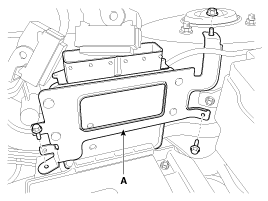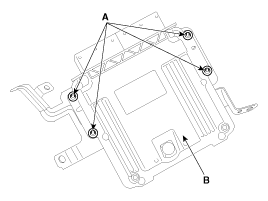|
When replacing the ECM, the vehicle equipped
with immobilizer must be performed the procedure as
below.
[In the case of
installing used ECM]
| 1. |
Perform "Neutral mode" procedure with
GDS. (Refer to "Immobilizer" in BE group)
|
| 2. |
Insert the key and turn it to the IGN ON
and OFF position. Then the ECM key register process is
completed automatically. |
[In the case of
installing new ECM]
| -
|
Insert the key and turn it to the IGN ON
and OFF position. |
Then the ECM key register process is completed
automatically.
|
| 1. |
Turn ignition switch OFF and disconnect the
negative (-) battery cable. |
| 2. |
Disconnect the ECM Connector (A).

|
| 3. |
Remove the battery (Refer to "Charging System"
in EM group). |
| 4. |
Remove the mounting bolts and nut, and then
remove the ECM assembly (A).

|
| 5. |
Remove the ECM (B) after removing 4 nuts (A)
from the bracket.

|
|
When replacing the ECM, the vehicle equipped
with immobilizer must be performed the procedure as
below.
[In the case of
installing used ECM]
| 1. |
Perform "Neutral mode" procedure with
GDS. (Refer to "Immobilizer" in BE group)
|
| 2. |
Insert the key and turn it to the IGN ON
and OFF position. Then the ECM key register process is
completed automatically. |
[In the case of
installing new ECM]
| -
|
Insert the key and turn it to the IGN ON
and OFF position. |
Then the ECM key register process is completed
automatically.
|
| 1. |
Installation is reverse of
removal.
ECM
installation nut:
9.8 ~ 11.8 N.m (1.0 ~ 1.2 kgf.m, 7.2 ~
8.7 lb-ft)
ECM bracket
installation nut/bolt:
9.8 ~ 11.8 N.m (1.0 ~ 1.2 kgf.m, 7.2 ~
8.7 lb-ft)
|
|
| ECM Problem Inspection
Procedure |
| 1. |
TEST ECM GROUND CIRCUIT: Measure resistance
between ECM and chassis ground using the backside of ECM harness
connector as ECM side check point. If the problem is found, repair
it.
|
| 2. |
TEST ECM CONNECTOR: Disconnect the ECM
connector and visually check the ground terminals on ECM side and
harness side for bent pins or poor contact pressure. If the problem
is found, repair it. |
| 3. |
If problem is not found in Step 1 and 2, the
ECM could be faulty. If so, make sure there were no DTC's before
swapping the ECM with a new one, and then check the vehicle again.
If DTC's were found, examine this first before swapping
ECM. |
| 4. |
RE-TEST THE ORIGINAL ECM: Install the original
ECM (may be broken) into a known-good vehicle and check the vehicle.
If the problem occurs again, replace the original ECM with a new
one. If problem does not occur, this is intermittent problem (Refer
to “Intermittent Problem Inspection Procedure” in Basic Inspection
Procedure). | |